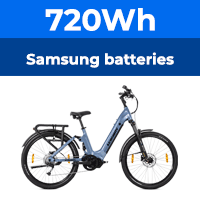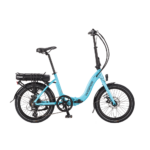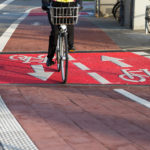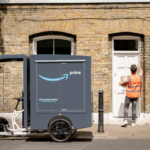This thread is for pedelecers with crank or bottom-bracket drives, or others which put the power through the chain ring.
I'm after insight about the effective way to use gears with a mid-drive e-assist.
I'm running a 48-36 double (plus a 24 for loaded touring or shopping, when it is hilly), and a 11-32 cassette on the back with a Gruber Assist, which is relatively weak in torque and gives me perhaps 25% to 100% assistance depending on the circumstances.
My controls are one button on the bar for on/off, the gear selected, and the amount of effort I put into pedalliing. I have decent components - mainly Deore or Deore XT.
I can also stop the motor by pausing pedalling - it will pause for a couple of seconds, and restart if I start pedalling again, or give a small wriggle for feedback as it disengages if I continue not to pedal.
This is a bit of thinking aloud, but I'd like to swap experiences. For a few starters, I find that :
- I can happily run up and down the 10-gear rear cassette all day without needing to come off the power.
- I can drop down a ring at the front under power without a problem.
- I *can* change to the bigger ring under power, but I don't do that out of concern for the small motor in the long term, and the slightly significant amount a replacement motor would cost. This may eb something to do with having good components.
- The nature of the response is that there is more assistance if I put more effort in, but it drops off as the speed rises, and becomes almost undetectable (motor silent) at a constant speed once I have accelerated to a reasonably steady speed.
- If I am riding the 36 tooth ring (gear range: 30 to 89 gear inches) there is no problem - I can just leave it and use the rear cassette.
- If I'm using the 48 tooth ring (gear range: 40 60 118 inches), dropping in to the smaller 36 ring at the front as I halt seems to be the way to ride eg road crossings, stopping the motor, then getting going and switching the motor back on when I am back in the big ring.
- If I am wanting to accelerate from a steady speed or put in more effort for eg a small hill, I can get more effort from the motor by either dropping a gear or two, or a chainring (= 2-3 gears difference), or pedal harder.
Gotchas
- I've been surprised that the main change of having an assist is that I tend to run in a higher gear than when the assist is off, rather than a higher cadence. Not expected.
Comments welcome.
Ferdinand
I'm after insight about the effective way to use gears with a mid-drive e-assist.
I'm running a 48-36 double (plus a 24 for loaded touring or shopping, when it is hilly), and a 11-32 cassette on the back with a Gruber Assist, which is relatively weak in torque and gives me perhaps 25% to 100% assistance depending on the circumstances.
My controls are one button on the bar for on/off, the gear selected, and the amount of effort I put into pedalliing. I have decent components - mainly Deore or Deore XT.
I can also stop the motor by pausing pedalling - it will pause for a couple of seconds, and restart if I start pedalling again, or give a small wriggle for feedback as it disengages if I continue not to pedal.
This is a bit of thinking aloud, but I'd like to swap experiences. For a few starters, I find that :
- I can happily run up and down the 10-gear rear cassette all day without needing to come off the power.
- I can drop down a ring at the front under power without a problem.
- I *can* change to the bigger ring under power, but I don't do that out of concern for the small motor in the long term, and the slightly significant amount a replacement motor would cost. This may eb something to do with having good components.
- The nature of the response is that there is more assistance if I put more effort in, but it drops off as the speed rises, and becomes almost undetectable (motor silent) at a constant speed once I have accelerated to a reasonably steady speed.
- If I am riding the 36 tooth ring (gear range: 30 to 89 gear inches) there is no problem - I can just leave it and use the rear cassette.
- If I'm using the 48 tooth ring (gear range: 40 60 118 inches), dropping in to the smaller 36 ring at the front as I halt seems to be the way to ride eg road crossings, stopping the motor, then getting going and switching the motor back on when I am back in the big ring.
- If I am wanting to accelerate from a steady speed or put in more effort for eg a small hill, I can get more effort from the motor by either dropping a gear or two, or a chainring (= 2-3 gears difference), or pedal harder.
Gotchas
- I've been surprised that the main change of having an assist is that I tend to run in a higher gear than when the assist is off, rather than a higher cadence. Not expected.
Comments welcome.
Ferdinand
Last edited:







